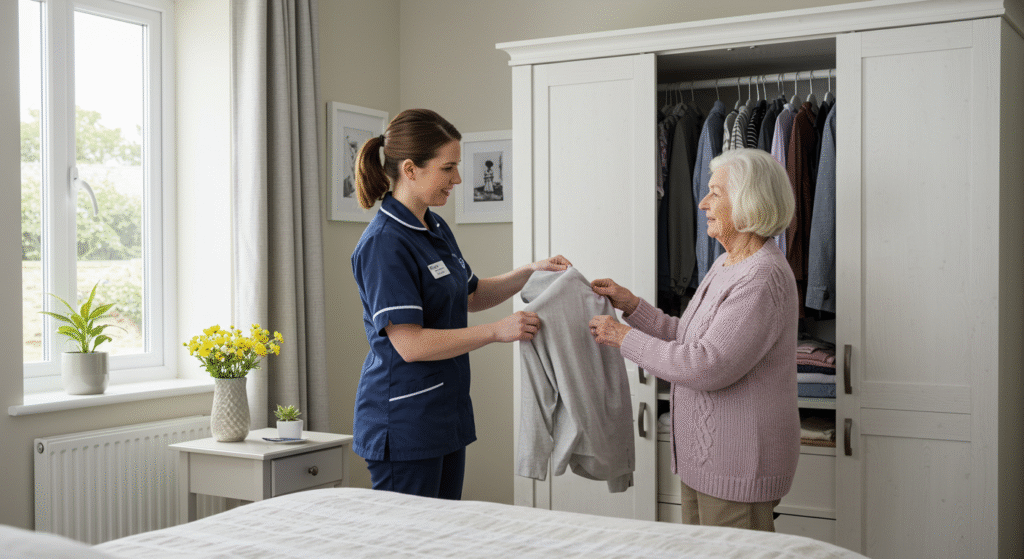For Personalized Live in Care Guidance
The Complete Guide - to Cost of live in care in 2025 What You Need to Know
Live-in care has become an increasingly popular alternative to residential care homes, offering personalized support in the comfort of one’s own home. As we move through 2025, understanding the costs associated with live-in care is essential for making informed decisions about long-term care options. This comprehensive guide breaks down everything you need to know about live-in care costs in the UK.
Understanding cost of live in care in 2025

The cost of live-in care in the UK typically ranges between £1,250 and £1,500 per week for standard care services. This price varies based on several factors including the level of care required, the complexity of medical needs, and the care provider you choose.
Here’s a breakdown of current live-in care costs:
- Standard Personal Care: £150 per day or £1,500 per week
- Companionship Care: £120 per day or £1,250 per week
- Complex Care: £200 per day or £1,650 per week
- Care for Couples: From £1,300-£1,400 per week (significantly more economical than two residential care places)
- For those requiring round-the-clock supervision from two carers, costs can reach approximately £2,000 per week.
Live-in Care vs. Care Home: Cost Comparison
When comparing live-in care with residential care options, it is essential to consider the complete financial picture. On average, a residential care home costs around £29,250 per year, which amounts to approximately £562 per week. In contrast, a nursing home averages £39,300 per year or about £755 per week. Private care homes can be even more expensive, often exceeding £1,500 per week, equating to over £78,000 annually. Live-in care typically ranges between £1,250 and £1,500 per week, translating to an annual cost of £65,000 to £78,000.
Although the weekly rate for live-in care may initially seem higher than basic residential care, it offers several significant advantages. One of the most important benefits is that there is no need to sell your home to cover the costs. Moreover, live-in care provides one-to-one personalized support, ensuring tailored attention and care. This option also proves to be more economical for couples since they can share a carer, making it about 40-50% more affordable compared to two separate residential care placements. Additionally, live-in care offers the flexibility to adjust the care level as needs change, all while allowing individuals to stay within familiar surroundings.
Cost of live in care : Additional Expenses and Funding Options
When planning for live-in care, it’s crucial to account for additional costs that might arise. While the core service fees cover most needs, there are a few extra expenses to consider.
Firstly, you may need to cover the carer’s food costs, as they typically share meals from the regular grocery shop. Travel expenses may also apply, particularly if the carer has to travel long distances or if you require short respite visits. Additionally, you might notice a slight increase in household bills, as having an extra person in the home can raise utility costs.
Accommodation is another consideration, as your carer will need a private space to stay. Furthermore, it’s essential to check your insurance policies, as some may require adjustments when a live-in carer is present.
Funding Your Live-in Care: Key Options to Explore
Fortunately, there are several ways to finance live-in care services:
- Local Authority Funding: If your assets are valued below £23,250, you might qualify for financial assistance.
- NHS Continuing Healthcare: This option is available for individuals with primary health needs.
- Direct Payments: Some councils provide personal budgets, giving you more control over how your care is managed.
- Equity Release: You may access the value of your property to fund your care.
- Attendance Allowance: This non-means-tested benefit is available for those who require care.
- Personal Independence Payment (PIP): If you are under 65 and living with a long-term health condition, you may be eligible.
- Pension Credit: Additional income support for those with low pension earnings.
- Savings and Investments: Some people choose to use personal funds to cover care expenses.
By understanding these additional costs and exploring available funding options, you can make more informed decisions about live-in care without compromising on the quality of support.
Additional Considerations for Live-in Care
When budgeting for live-in care, consider these additional factors:
- Your live-in carer will need a separate bedroom and storage space
- Internet connection for digital care monitoring (increasingly important in 2025)
- Food allowance for your carer (typically included in weekly costs)
- Potential home modifications for accessibility and safety

Factors Affecting Live-in Care Costs
Several elements influence the overall cost of live-in care services:
- Level of care required – Personal care needs versus companionship only
- Complexity of medical conditions – Specialized care for conditions like dementia may require additional training
- Duration of care – Long-term arrangements versus short-term respite care
- Location – Costs can vary depending on where you live in the UK
- Experience of the carer – More experienced carers may command higher rates
- Agency fees and administration – Different providers have varying overhead costs
Specific requirements – Special dietary needs or mobility equipment may affect pricing
How to Reduce Cost of live in care

- If you're concerned about the cost of live-in care, consider these strategies to make it more affordable:
- Shared care arrangements: Family members providing care for part of the week.
- Tax relief: Some care expenses may qualify for tax benefits.
- Benefits check: Ensure you're receiving all entitled benefits.
- Compare providers: Different agencies have different pricing structures.
- Consider direct employment: Hiring a carer directly can reduce agency fees.
- Explore respite options: Mixing live-in care with other support services.



The Value of Live-in Care: Beyond the Price Tag

While cost is an important consideration, the value of live-in care extends far beyond financial aspects:
- Independence and dignity: Maintaining your own routine in familiar surroundings.
- Personalized care: One-to-one attention tailored to individual preferences.
- Continuity of care: Consistent support from a dedicated carer.
- Peace of mind: For both the care recipient and their family.
- Holistic support: Assistance with all aspects of daily living.
- Reduced risk of infections: Fewer exposure opportunities compared to care homes.
- Maintained social connections: Staying within your community and neighborhood.
- Pet companionship: Ability to keep beloved pets, which is often not possible in care homes.
Hear What Our Clients Says
Frequently Asked Questions
How much does live-in care cost per month?
On average, live-in care costs between £5,000 and £6,500 per month, depending on the level of care required and your location in the UK.
Is live-in care more expensive than a care home?
For individuals, live-in care is typically more expensive than basic residential care but comparable to high-quality nursing homes. For couples, live-in care is almost always more economical than two care home placements.
Can I get financial help for live-in care?
Yes, depending on your financial situation and care needs, you may be eligible for local authority funding, NHS Continuing Healthcare, or various benefits like Attendance Allowance.
Do I need to pay for the carer's food and accommodation?
Yes, you’ll need to provide a private bedroom for your carer and cover their food costs, typically by including them in your regular grocery shopping.
How do care agency fees work?
Care agencies charge a fee that covers carer recruitment, training, management, and replacement carers during holidays or illness. This is usually included in the weekly rate quoted.
At Tier One Care, we understand that finding affordable, high-quality care is essential. That’s why we offer our “We Won’t Be Beaten on Price” guarantee, ensuring you receive the best possible care at competitive rates.
Our compassionate, professionally trained carers provide personalized support tailored to your unique needs, whether you require assistance with personal care, medication management, meal preparation, or companionship.
Making the Right Choice for Your Care Needs
When considering live-in care, it’s important to:
- Assess your care needs – Be honest about the level of support required
- Research thoroughly – Compare different providers and their offerings
- Check qualifications – Ensure carers are properly trained and vetted
- Read reviews – Look for testimonials from current or past clients
- Ask about replacement cover – Understand what happens when your regular carer needs time off
- Consider cultural fit – The relationship between carer and client is crucial

Contact Us
Phone: 08085013866
Email: support@tieronecare.co.uk
Head office
182-184 High Street North
East Ham
London
E6 2JA
Information
About Us
Careers
Blog
Legal
Privacy Policy
Cookie Policy
Terms & Condition




